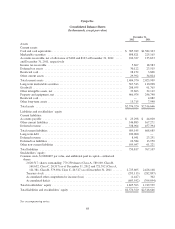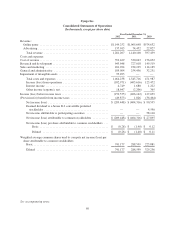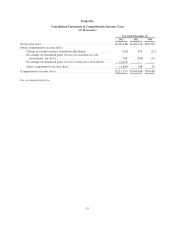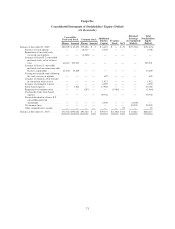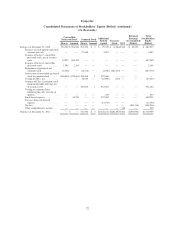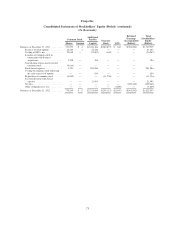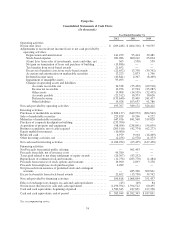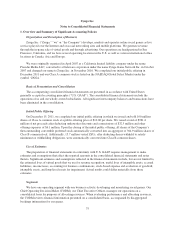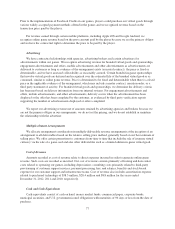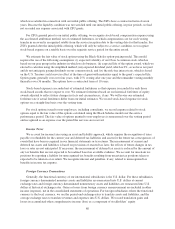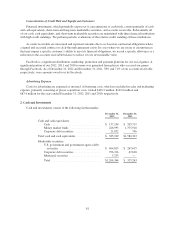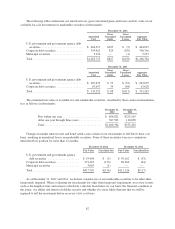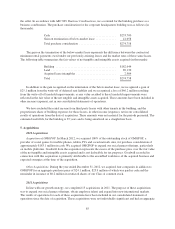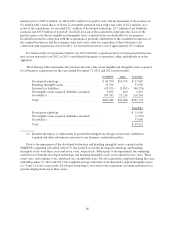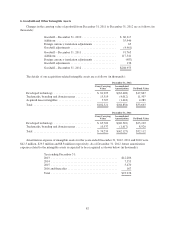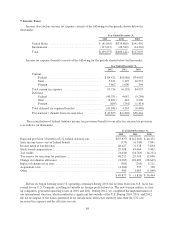Zynga 2012 Annual Report Download - page 86
Download and view the complete annual report
Please find page 86 of the 2012 Zynga annual report below. You can navigate through the pages in the report by either clicking on the pages listed below, or by using the keyword search tool below to find specific information within the annual report.Marketable Securities and Non-Marketable Securities
Marketable securities consist of U.S. government-issued obligations, municipal securities and corporate debt
securities. Management determines the appropriate classification of marketable securities at the time of purchase
and reevaluates such determination at each balance sheet date. The fair value of marketable securities is
determined as the exit price in the principal market in which we would transact. Based on our intentions
regarding our marketable securities, all marketable securities are classified as available-for-sale and are carried at
fair value with unrealized gains and losses recorded as a separate component of other comprehensive income, net
of income taxes. Realized gains and losses are determined using the specific-identification method and are
reflected as a component of other income (expense), net in the consolidated statements of operations when they
are realized. When we determine that a decline in fair value is other than temporary, the cost basis of the
individual security is written down to the fair value as a new cost basis and the amount of the write-down is
accounted for as a realized loss in other income (expense), net. The new cost basis will not be adjusted for
subsequent recoveries in fair value. Determination of whether declines in fair value are other than temporary
requires judgment regarding the amount and timing of recovery. No such impairments of marketable securities
have been recorded to date.
For non-marketable securities in which we exercise significant influence on the equity to which these non-
marketable securities relate, we apply the equity method of accounting. Our non-marketable securities are subject
to periodic impairment reviews.
Restricted Cash
Restricted cash consists of collateral for facility operating lease agreements and funds held in escrow in
accordance with the terms of certain of our business acquisition agreements.
Derivatives and Hedging
We account for derivative financial instruments in accordance with Accounting Standards Codification
(“ASC”) 815, Derivatives and Hedging, which requires that every derivative instrument be recorded on the
balance sheet as either an asset or liability measured at its fair value as of the reporting date. ASC 815 also
requires that changes in our derivatives’ fair values be recognized in earnings, unless specific hedge accounting
and contemporaneous documentation criteria are met, in which case, the change in fair value related to the
effective portion of the hedge may be recognized as a component of accumulated other comprehensive income
(i.e., the instruments qualify for hedge accounting treatment). Any ineffective or excluded portion of a designated
cash flow hedge is recognized in earnings.
Accounts Receivable and Allowance for Doubtful Accounts
Accounts receivable are recorded and carried at the original invoiced amount less an allowance for any
potential uncollectible amounts. We review accounts receivable regularly and make estimates for the allowance
for doubtful accounts when there is doubt as to our ability to collect individual balances. In evaluating our ability
to collect outstanding receivable balances, we consider many factors, including the age of the balance, the
customer’s payment history and current creditworthiness, and current economic trends. Bad debts are written off
after all collection efforts have ceased. We do not require collateral from our customers.
Property and Equipment
Property and equipment are stated at cost less accumulated depreciation. Depreciation is recorded using the
straight-line method over the estimated useful lives of the assets. Leasehold improvements are amortized over the
shorter of the estimated useful lives of the improvements or the lease term.
78


